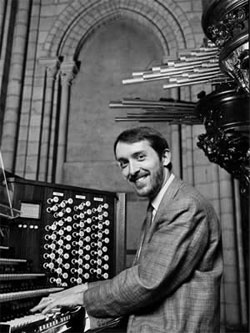
The program — made up entirely of dance music from several centuries — will culminate in an improvisation on a submitted theme, a specialty of French organists, who tend to improvise much of the music they provide when they play for masses. Latry’s playlist includes Suzann van Soldt’s Sept Danses, Buxtehude’s Passacaglia, J.S. Bach’s Fugue in G (Gigue) & Passacaglia et thema fugatum, Khachaturian’s Sabre Dance, de Falla’s Ritual Fire Dance, Karg-Elert’s Valse mignonne, Vierne’s Fantômes (Pièces de fantaisie) and Saint-Saëns’ Dance macabre.
John McElliott, president of Cleveland’s own Karen McFarlane Artists, Inc., which represents Latry and some forty other internationally famous organists, kindly arranged for a phone interview at Latry’s home in a suburb of Paris.
DH: I believe that you’ve concertized in Northeast Ohio before?
OL: Yes, I have played both in Cleveland and Akron.
DH: How long is your current tour?
OL: I think it’s about two weeks. I am in the US about two or three times a year.
DH: What are your favorite destinations in the US? Where do you like to go?
OL: It’s difficult to say, because the United States are so different, from the east coast to the west coast, to the middle.
DH: Almost as varied regionally as France?
OL: Yes, but much bigger. It’s very attractive what we can find in the US — the changes from place to place. And they also have many good organs everywhere.
DH: You are a very versatile player — you play music from all eras. What are some of the more interesting organs you’ve encountered here?
OL: I’ve played the Taylor & Boody organ at Holy Cross Chapel in Worcester (Massachusetts), the Fisk at Stanford University, the organ in Woolsey Hall at Yale, and in this tour, I will also play the organ in St. John the Divine in New York, which is a very nice instrument, I’ve heard.
DH: Yes, it was just recently restored. I think you must have enjoyed designing your program for Akron — it’s all dance music!
OL: I love that theme, because all the ancient music was composed in dance forms even for church. The model was popular music, and dance was the inspiration for all music in the 17th and beginning of the 18th century. Even for churches. There is, for example, a French composer who composed a book for organ and said the organist who plays his pieces has to find the dances which he put in his music, just to find the right character. The only thing he requested is just to play a little bit slower because the churches require something more religious and less dynamic than in the concert hall.
DH: Even the Passacaglia was originally a dance.
OL: Yes, of course. And I wanted to pursue this idea in the 19th and 20th century. That’s why I put the pieces by Vierne and especially Saint-Saëns. The program is based on music both written for the organ and transcriptions.
DH: It will be fun to hear Khachaturian, De Falla and Karg-Elert — I don’t know the Valse mignonne.
OL: It’s a very charming piece which was written for the Wanamaker Organ in Philadelphia.
DH: On your program in Akron you’ll do an improvisation. Will that be dance-based as well?
OL: I don’t know. It really depends on the theme that I get. I won’t decide first. The theme will give me the style.
DH: What is the strangest tune you’ve ever been asked to improvise on?
OL: There were so many!
DH: I want to ask you a bit about what you do at Notre-Dame. How many Titulaires are there at the moment?
OL: We are three organists. Usually we each play once every three weeks — on the weekends. If something happens during the week, the organist who played the last Sunday will play during the week, but it’s very rare. Because of our concert engagements, we organize the Notre-Dame schedule three or four years in advance. So we know now who will play for Christmas in 2013.
DH: You are a long way away from the altar at Notre-Dame — at the opposite end of the building, in fact. How do you communicate?
OL: Oh, we have a lot of things. We have three different cameras, a video monitor, loudspeakers, two telephones, we have some lights — green to begin, and red to stop.
DH: What is it like to be a musician in one of Paris’ major tourist destinations. When do you practice?
OL: Of course, the main point is not the tourists. It’s the building and its history and what it is made for. It’s an incredible place, and for me, the best time is at night when the tourists are gone. Being alone in that building is just something really impressive. You just can’t describe it.
DH: I can remember playing at Winchester Cathedral and being locked in after the tourists left. It’s a fabulous feeling.
OL: I think it’s also very nice for organists to be able to play in that kind of building. I remember once I played in the same week in Birmingham Symphony Hall — which is a brand-new building, very nice — then I flew to Spain to a very small village in the mountains in the middle of nowhere and then I came back to Paris and played in the castle at Versailles, then I played for the masses at Notre-Dame. Four totally different places. And this is the best part of being an organist I think — being to play magnificent organs in magnificent places.
Olivier Latry’s concert on Friday, October 9, at 8 pm in Holy Trinity Lutheran Church, 50 N. Prospect St. in Akron, is free.



